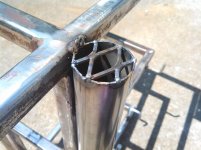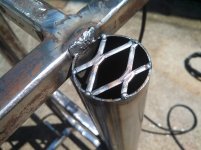joshuabardwell
Elite Member
When I was shopping for a welder, I wanted to get something that would do TIG, in part because TIG is awesome and beautiful, but also because TIG allows welding of thinner material than stick. So far, I have been TIG'ing 1/8" material that I could have done with stick, it just wouldn't have been as pretty. But today, for the first time, I welded something that would have been near-impossible (at least for me) with stick.


Weld parameters were 3/32" electrode, about 30 amps output (fixed).
These are tubes intended to hold 3-lb packages of TIG filler rod on my welding cart. I put expanded metal on the bottom for two reasons--first, because it would let dirt and dust fall through, and second, because it was much easier to cut a circle of expanded metal with a hole saw than it would have been to cut 1/8" sheet/flat stock.
On the left, you can see where I welded the 16-ga round tube to the 1/8" square tube of the cart's body with 3/32" 6011 at about 65 amps. I built up a puddle on the 1/8" tube and then carried it over until it just melted into the 16-ga. In order to avoid overheating the metal, I did a series of side-by-side tacks, instead of one bead, and let the metal cool in between the tacks.
For the expanded metal, I knew there was no way I could do it with stick. I have welded this same expanded metal with 3/32" 6011 before, to a piece of 1/8" angle iron. I used the same technique of building the puddle on the 1/8" then melting over, but a few things were different. First, I melted over to the thicker center of the "x" whereas here I would be welding the thinner legs of the "x". I know from experience that they just evaporate. Second, I was concerned about building a puddle on the 16-gauge without blowing through. Third, I would be working at the very edge of the 16-gauge, which increases greatly the chances of blowing through.
I ended up using the same basic technique, though: build some heat on the side-wall of the tube, then carry the puddle up and add filler to the joint. The resulting welds are, without a doubt, full of flaws, but I'm still proud that I was able to stick this stuff together without it just up and melting away to nothing.
I did have an interesting thing happen. When I was welding, sometimes the arc would blow away like a flame in front of a fan. I was outdoors, so a breeze is a possibility, but the tungsten didn't act like it was losing shielding, so I wasn't sure whether that would be consistent with wind or not. Then again, with a gas lens, maybe the wind was blowing the arc around, but the tungsten was still shielded. It was more likely to happen when I was aiming down into the top of the tube, so I also wondered if maybe the wall of the tubing was kind of splitting the gas flow and causing turbulence that was blowing it around. I dunno.
One final thought: what does it mean if, as you're welding, suddenly the arc gets MUCH brighter and you can see the weldment almost as if you weren't wearing your hood? IT MEANS YOU FORGOT TO SET YOUR WELDING HOOD BACK TO HIGH SENSITIVITY AFTER YOU GOT DONE STICK WELDING! Duhhh.... This is the first time I've welded at low enough amps with TIG for it to even matter. Good thing the lens is always UV blocking, even when it's not dark. And good thing it was only 30 amps and not 150 amps... Still darn bright, though.


Weld parameters were 3/32" electrode, about 30 amps output (fixed).
These are tubes intended to hold 3-lb packages of TIG filler rod on my welding cart. I put expanded metal on the bottom for two reasons--first, because it would let dirt and dust fall through, and second, because it was much easier to cut a circle of expanded metal with a hole saw than it would have been to cut 1/8" sheet/flat stock.
On the left, you can see where I welded the 16-ga round tube to the 1/8" square tube of the cart's body with 3/32" 6011 at about 65 amps. I built up a puddle on the 1/8" tube and then carried it over until it just melted into the 16-ga. In order to avoid overheating the metal, I did a series of side-by-side tacks, instead of one bead, and let the metal cool in between the tacks.
For the expanded metal, I knew there was no way I could do it with stick. I have welded this same expanded metal with 3/32" 6011 before, to a piece of 1/8" angle iron. I used the same technique of building the puddle on the 1/8" then melting over, but a few things were different. First, I melted over to the thicker center of the "x" whereas here I would be welding the thinner legs of the "x". I know from experience that they just evaporate. Second, I was concerned about building a puddle on the 16-gauge without blowing through. Third, I would be working at the very edge of the 16-gauge, which increases greatly the chances of blowing through.
I ended up using the same basic technique, though: build some heat on the side-wall of the tube, then carry the puddle up and add filler to the joint. The resulting welds are, without a doubt, full of flaws, but I'm still proud that I was able to stick this stuff together without it just up and melting away to nothing.
I did have an interesting thing happen. When I was welding, sometimes the arc would blow away like a flame in front of a fan. I was outdoors, so a breeze is a possibility, but the tungsten didn't act like it was losing shielding, so I wasn't sure whether that would be consistent with wind or not. Then again, with a gas lens, maybe the wind was blowing the arc around, but the tungsten was still shielded. It was more likely to happen when I was aiming down into the top of the tube, so I also wondered if maybe the wall of the tubing was kind of splitting the gas flow and causing turbulence that was blowing it around. I dunno.
One final thought: what does it mean if, as you're welding, suddenly the arc gets MUCH brighter and you can see the weldment almost as if you weren't wearing your hood? IT MEANS YOU FORGOT TO SET YOUR WELDING HOOD BACK TO HIGH SENSITIVITY AFTER YOU GOT DONE STICK WELDING! Duhhh.... This is the first time I've welded at low enough amps with TIG for it to even matter. Good thing the lens is always UV blocking, even when it's not dark. And good thing it was only 30 amps and not 150 amps... Still darn bright, though.
